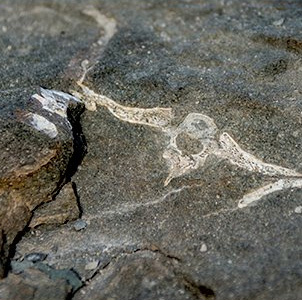|
That Which Remains... From a Global Extinction 
National Science Foundation Posted March 5, 2018 Image: Mike Lucibella, NSF The fossilized remains of the vertebra and foot of a lystrosaurus, a plant-eating dinosaur which lived about 250 million years ago, embedded in exposed rock high in the mountains of Antarctica. The find was made by a team of paleontologists, led by Christian Sidor, of the University of Washington, who were working this Southern Hemisphere summer in the Transantarctic Mountains, near the Shackleton Glacier. They gathered fossil specimens to try to piece together how animals in what is now Antarctica coped with a massive shift in climate. (https://www.nsf.gov/awardsearch/showAward?AWD_ID=1341304) Roughly 252 million years ago, a major mass extinction wiped out upwards of 90 percent of species on Earth. At the same time, the Antarctic portion of the supercontinent of Pangea transitioned to a warmer climate and its glaciers melted. Little is known about the survivors of the extinction in Antarctica, although scientists believe that the continent's high-latitude location shielded it from the worst of the extinction's effects.
|



For USAP Participants |
For The Public |
For Researchers and EducatorsContact UsU.S. National Science FoundationOffice of Polar Programs Geosciences Directorate 2415 Eisenhower Avenue, Suite W7100 Alexandria, VA 22314 Sign up for the NSF Office of Polar Programs newsletter and events. Feedback Form |

